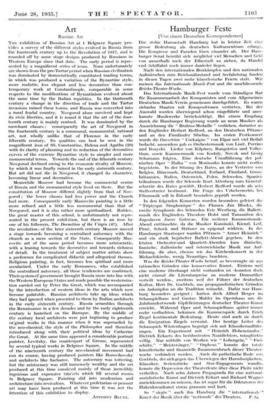Art
Russian Art
THE exhibition of Russian Art at 1- Belgrave Square pro- vides a survey of the different styles evolved in Russia from the fourteenth century up to the Revolution of 1917, and is rounded off by some stage designs produced by Russians in Western Europe since that date. The early period is repre- sented by a magnificent series of icons. None unfortunately are shown from the pre-Tartar period when Russian civilization was dominated by democratically constituted trading towns, in which was produced a variation of the Byzantine style, more realistic, less elegant and less decorative than con- temporary work at Constantinople, comparable in some respects to the modifications of Byzantinism evolved about the same time by the Italian republics. In the thirteenth century a change in the direction of trade and the Tartar invasions ruined these towns, and Russia was converted into a rural feudal country. Novgorod alone survived and kept its civic liberties, and it is round it that the art of the four- teenth century is mainly centred. It was dominated by the merchant classes ; consequently the art of Novgorod in the fourteenth century is a communal, monumental, rational art, not wholly unlike that of Florence in the early fifteenth century. Its qualities can best be seen in the magnificent icon of SS. Constantine, Helena and Agatha (20) with its clarity of planning and its reduction of the decorative curves of the extreme Byzantine style to simpler and more monumental terms. Towards the end of the fifteenth century Novgorod declined owing to the economic rivalry of Moscow, by which it was finally ruined in the early sixteenth century. But art did not die in Novgorod, it changed its character, becoming linear and decorative.
Meanwhile Moscow had become the commercial centre of Russia and the monumental style lived on there. But the constitution of Moscow differed slightly from that of Nov- gorod ; the lower classes had less power and the Church had more. Consequently early Muscovite painting is a little more refined and a little less monumental than that of Novgorod, and it is also rather more spiritualized. Rublev, the great master of this school, is unfortunately not repre- sented in the present exhibition, but there is an icon by one of his followers, The Dominion of the Virgin (47). After the revolutions of the later sixteenth century Moscow moved a stage towards becoming a centralized autocracy with the ehurch as a mere section of the State. Consequently Mus- covite art of the same period becomes more aristocratic, with a leaning towards the decorative and towards richness of detail. In the treatment of subject matter artists show a preference for complicated didactic and allegorical themes. Religious painting, in fact, becomes less spiritual and more secularized. Under the early Romanovs, who established the centralized autocracy, all these tendencies are confirmed. Their system of government brought Russia more into line with the Western European States and made possible the westerniza- tion carried out by Peter the Great, which was accompanied by the introduction of western ideas in the arts which now become palatable. Russian architects take up ideas which they had ignored when presented to them by Italian architects in the early sixteenth century. Russia scrambles through the Renaissance in a few decades and by the early eighteenth century is launched on the Baroque. By the middle of the century local architects were just beginning to produce original works in this manner when it was superseded by the neo-classical, the style of the Philosopher and therefore introduced along with their political ideas by Catherine the Great. At the same time appeared a considerable portrait painter, Levitzky, the counterpart of Greuze, represented by several typical works in Belgrave Square. In the middle of the nineteenth century the neo-classical movement had run its course, having produced painters like Borovikovsky and architects like Sacharov. The autocracy was tottering, but the aristocracy was still immensely wealthy and the art produced at this time consisted mainly of those incredibly ingenious and expensive trinkets which fill several rooms in Belgrave Square. Painting slid into academism and architecture into revivalism. Whatever proletarian or peasant art may have been produced at this time it was not the intention of this exhibition to display.
ANTIIONY BLUNT.






































 Previous page
Previous page